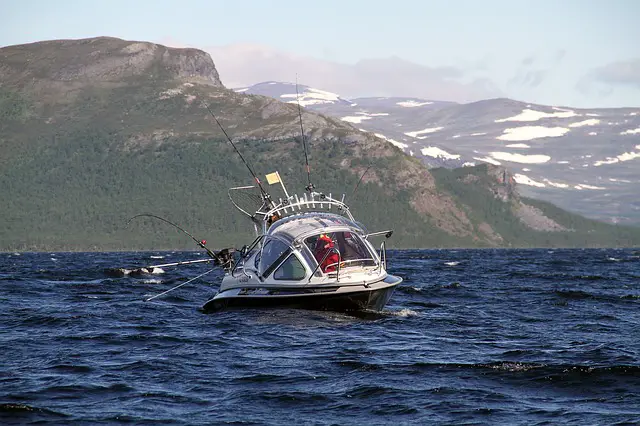
Once you get to troll for fish in the open ocean, then you’ll get to experience the appeal
in fishing many search for. Master anglers understand the thrill and would at any time jump at
the challenge of trolling in this situation. As a beginner, you have a whole
lot to practice on before you can even think of trolling. Once you get the
hang of it, after managing to catch a fish where the majority can’t, your
ultimate fishing challenge — and which any serious angler you know aspires to
master — would be trolling.
The open ocean, as you know, is the natural habitat of numerous species of pelagic fish,
and it’s upon you, the angler, to figure out how best you’re going to capture a
ton of them and bring them home with you. You’ve probably dreamt about catching
some salmon, tuna, trout, kingfish, dorado, and even bill fish such as marlin
and sailfish.
While you have all the fishing techniques in the world to choose, trolling sticks out for
the simple reason that you’ll be using more than one fishing line, all set at
the back of your boat with the bait fish or lures lagging behind, to catch the
most fish at a go. And while at it, you have the option to remain in a static
position and wait for the fish to come to you or to keep on moving your boat as
the lines are drawn from side-to-side to attract the fish.
At basic level, trolling is a cinch. After all, all you have to do is put out several
fishing lines and move your boat. When you look at it deeply, it takes a lot of
practice, coordination, and skill for you to be able to consistently catch fish
with the odds stacked against you by the ever changing ocean conditions. As a
beginner, here’s a step by step guide you can follow today to learn more about
trolling and how to do it right:
Get the Right Set of Gear
Before you even think of anything or the techniques to employ, make sure you’ve invested
in the right set of trolling gear. Make sure you have the right reels, rods,
and fishing line. Speaking of which, the lines used in trolling are usually
long (about 7.5 to 9 feet long), in addition to featuring forgiving tapers. Also
required are bait-casting reels with which you’ll be using to estimate the
length of line that’s out or the depth of your bait. Goes without mentioning
that you need planer boards to stretch out your trolling spreads. Fortunately
for you, you don’t necessarily need to break the bank to acquire the right
trolling gear. If anything, it’s possible to find quality entry-level rods,
lines, and counter reels for less than $100. If your plan is to venture into
trolling with all the seriousness it deserves, then spending on the right gear
combo should be the first investment you make.
Be Strategic
When you finally decide to cast, don’t just rush into launching the boat and immediately
head to a bank near you and start firing the casts. Not so fast — instead,
start by figuring out the right kind of lure to use. Study the map or aerial
representation of the area and conjure a plan before getting into the water.
The most idea places to start including the break lines, stumpy flats, point,
and the river or creak channels. While going through the map, identify a route
and make a point to stick to it at all times while you’re out fishing.
Start Small, but Work bigger
Don’t overplay yourself — at the same time, be willing to work extra hard and keep
growing. Tournament pros and walleye guides have the experience and technical
expertise needed to run 6 boards, while controlling the boat, catching fish,
and trolling through swells. They have done this several times and, in the
process, have managed to acquire the much-needed experience through practice. But
as a beginner, don’t let any of this demoralize you. With baby steps, you’ll
eventually get there, but it’s going to take a lot of effort and determination
on your part to acquire this level of mastery. Three lines with a planer board
attached to each side, and just one line at the back is enough if you’re
starting out. Take your time to experiment with this until you become
comfortable with it and you’ll be allowed to throw in more complexities to your
spread. When you come to think of it, an angler with only three lines but has
the right amount of skills is more likely to catch more fish as opposed to one
with 10 or more lines out that are far off from the strike zone and are
consistently getting tangled up.
Keep Moving
One common mistake inexperienced trollers make all the time is stopping when they
shouldn’t. They hook up a fish, and out of the hoopla, set their boats into
neutral. While this may appear like a smart move on their part, what they’re
doing is setting their boats up for a snag. Regardless of what happens, it’s
important to keep your boat moving. Even when fighting a fish, do it while the
boat is moving and not in-situ. The same can be said about putting out lines or
when reeling in the spread. In which case, you have a better chance of
unsnagging when your boat is moving, considering the current will be pushing
everything towards the back of your boat.
Keep Changing Your Boat Speed
Walleyes are known for being speed sensitive. So don’t make the mistake of cruising at the
same speed all through. The trick is to start out slow, say, at a speed of 2.0
mph for cranks and about 1.0 for harnesses, and slowly accelerate it if the
slow speed is NOT attracting any bit. It’s through doing this that you’ll be
able to come up with a key speed with which you’ll be attracting the highest
number of bits.
Experiment with Multiple Presentations
Don’t stick to just one color. For what’s worth, walleyes are known for being very
particular about baits and colors. Meaning, you’d want to experiment with a
wide range of colors and baits throughout your spread. You have multiple lines,
so let the fish decide on the color and bait to go for. If you’re trolling in
an area you’re certain holds fish — but for some reasons, you’ve yet to
attract a bit — then why NOT do yourself a favor and consider changing the
baits or colors after every 15 minutes until you start attracting bits. The
same trick applies on hard baits and crawler harnesses, as well.











Pingback: What is the Difference between Catfish and White Bass? Identifying Key Characteristics | Reel Fishing Guru